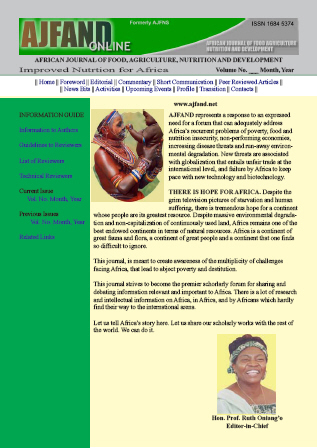
|
African Journal of Food, Agriculture, Nutrition and Development
Rural Outreach Program
ISSN: 1684-5358
EISSN: 1684-5358
Vol. 19, No. 3, 2019, pp. 14555-14570
|
 Bioline Code: nd19043
Bioline Code: nd19043
Full paper language: English
Document type: Research Article
Document available free of charge
|
|
|
African Journal of Food, Agriculture, Nutrition and Development, Vol. 19, No. 3, 2019, pp. 14555-14570
| en |
ASSESSMENT OF DIETARY DIVERSITY, ANTENATAL CARE, FOOD TABOOS, MEAL FREQUENCY, AND NUTRITIONAL STATUS OF PREGNANT ADOLESCENTS IN RURAL MALAWI: A CROSS-SECTIONAL STUDY
Walters, C; Bendulo, P & Stoecker, BJ
Abstract
High rates of pregnancy during adolescence in Malawi compromise the nutritional status
of adolescent mothers and their infants. When a pregnant adolescent is malnourished,
she is at risk for health complications. Research focusing on the nutritional status of
pregnant adolescents in Malawi is minimal. The purpose of this study was to assess
dietary diversity, antenatal care, food taboos, meal frequency, and nutritional status of
pregnant adolescents in rural Malawi. The study included sixty-two pregnant adolescents
between 15-19 years old. Data collection included the use of a pre-tested questionnaire,
standardized dietary diversity survey and measurements of mid-upper arm circumference
(MUAC), height, and hemoglobin. Statistical analysis included descriptive analysis,
linear and logistic regression. Mean (SD) age was 17.7 (1.2) years. Mean MUAC was
25.9 (2.0) cm; 31% had MUAC <25 cm. The occurrence of stunting was 19% and 21%
were ≤150 cm tall. The mean hemoglobin was 10.37 (1.93) g/dL and 66% were anemic.
The mean dietary diversity score was 4.06 (1.18) and 69% did not achieve minimum
dietary diversity (score ≥ five.) No participants consumed dairy and only 7% consumed
eggs. Eating meat and poultry or dark green leafy vegetables predicted a 1.31g/dL (p-value
= 0.0306) or 1.08 g/dL (p-value =0.0331) increase in hemoglobin levels,
respectively (R2=0.15). Food taboos during pregnancy were common (35%). Compared
to the Malawi National Nutrition Guidelines, 87% were not eating daily from each of the
six food groups and 74% were not meeting the recommended meal frequency during
pregnancy (three meals and at least one snack/day). Less than 50% consumed foods from
legumes/nuts and animal food groups. The majority (63%) did not take antenatal
supplements and only 37% consumed ferrous sulfate. Only 52% received advice about
nutrition during pregnancy and few (8%) received advice about infant and young child
feeding. Girls who received nutrition advice were more likely to take an iron supplement
[OR=4.19 (1.82-9.68), p=0.0008] compared to those who did not. As the number of
antenatal visits increased, the participants were more likely to take a supplement
[OR=11.88 (3.40-41.49) p=0.001]. Interventions for pregnant adolescents in rural
Malawi should occur early in pregnancy and include education on dietary diversity,
increasing hemoglobin levels, meal frequency, food taboos, antenatal supplements and
infant and young child feeding.
Keywords
Adolescent nutrition; Pregnant adolescents; Dietary diversity; Food taboos; Hemoglobin
|
| |
© Copyright 2019 - African Journal of Food, Agriculture, Nutrition and Development
Alternative site location: http://www.ajfand.net/
|
|
